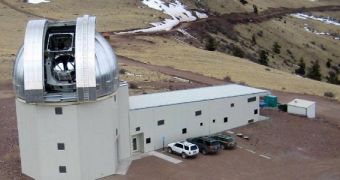Scientists from the New Mexico Institute of Mining and Technology in Socorro, New Mexico, say that a new telescope instrument will soon begin observing the night sky, in search for extrasolar planets. The New Mexico Exoplanet Spectroscopic Survey Instrument (NESSI) is a multi-object near-infrared spectrometer installed on the Magdalena Ridge Observatory (MRO) 2.4-meter (8-foot) Telescope.
The main goal of NESSI will be to help astronomers decipher the chemical composition of multiple exoplanets to be detected by either this instrument or by assets such as the NASA Kepler Telescope. The science team behind the project has already decided to focus its effort on a total of 100 exoplanets.
NESSI saw first light on April 3, 2014, and mission managers are currently working on making the final calibrations and assessments before the telescope instrument is commissioned to observe the night sky at full capability. The principal science investigator for this experiment is MRO project scientist Dr. Michelle Creech-Eakman.
She says that the first targets NESSI observed on April 3 were the star Pollux in the constellation Gemini (The Twins) and the large star Arcturs, in the constellation Boötes. These observations were conducted in order to confirm that all of the instrument's modes could be accessed. The images also certified the resolution and capabilities of the spectrometer.
“After five years of development, it's really exciting to turn on our instrument and see its first light. Planet hunters have found thousands of exoplanets, but what do we know about them? NESSI will help us find out more about their atmospheres and compositions,” Creech-Eakman explains. The experiment was partially funded by NASA through its Experimental Program to Stimulate Competitive Research.
The 100 science targets that have been selected for NESSI include planets ranging in size from super-Earths to gas giants and hot Jupiters. Existing technologies are insufficiently developed to observe Earth-like exoplanets orbiting within their parent stars' habitable zones, but future developments will undoubtedly make that a reality.
Due to the fact that the spectrometer will be able to observe a wide range of wavelengths in near infrared, “we can probe multiple signatures of molecules all at the same time, a special feature of NESSI,” comments NESSI project astronomer Mark Swain, who is based at the NASA Jet Propulsion Laboratory (JPL) in Pasadena, California.
The spectrometer is also expected to draw a lot of attention to exoplanetary studies, particularly among undergraduate students. “We're watching the next generation of scientists and engineers get excited about exoplanets. Who knows what they will be able to see when they're older – perhaps the atmospheres of potentially habitable worlds,” Creech-Eakman concludes.

 14 DAY TRIAL //
14 DAY TRIAL //